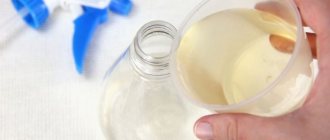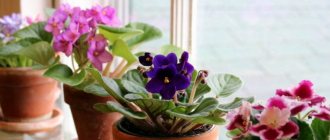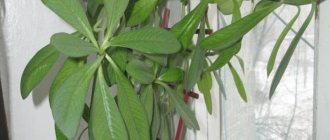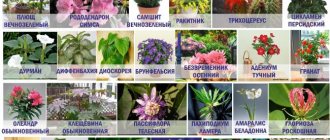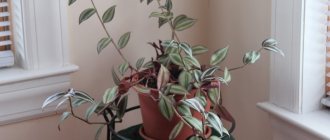Water hyacinth
The bizarre flower is found naturally in Brazil and South America. It grows on the surface of reservoirs and produces blue or purple spike-shaped inflorescences.
At home, water hyacinth is grown in an aquarium. It requires good lighting, warmth and water with fertilizers. In favorable conditions, the flower grows quickly and produces new leaves.
Sand and peat are poured onto the bottom of the aquarium for rooting. The rosette should float on the surface. Its roots absorb harmful substances and heavy metals from the water.
Heartleaf Aster
This herbaceous plant is a flowering low shrub. The shoots of the cordifolia aster are erect, dense, reddish-brown in color, reaching a height of 90 cm. The oval leaves are slightly rough to the touch.
The flowering period lasts from early June to mid-August. At this time, small basket flowers bloom on the bush, collected in paniculate inflorescences. Aster petals have an attractive bluish-purple color.
Tillandsia
An unusual plant takes water and substances necessary for growth from the air. Its leaves grow in the shape of a rosette. For its extraordinary ability to grow without soil, the plant is called an air flower.
For beauty, tillandsia is placed in various decorative trays, grown on a piece of bark or shell, on a tree branch or in an aquarium.
Bright light and constant exposure to water are not recommended. It is necessary to ventilate the plant so that it does not rot.
Where to place tillandsia and what temperature to maintain?
As already mentioned, you don’t need land to grow an air flower. For this reason, it is necessary to look for a flower without roots not in pots, but in the form of decorative compositions on bark or stone. Before purchasing such a unique plant, you must immediately think about the intended location for its cultivation. As a support for the plant, you can use, for example, wood cut into rings or beautiful stones. brought from the sea, as well as roots. The main thing is that the plant has the right conditions that will not interfere with the growth of shoots and roots. You can attach the flower with soft wire, nylon threads or waterproof glue. Under no circumstances should you use any material treated with paint or varnish for these purposes. It is also worth considering the fact that the atmospheric flower categorically does not tolerate high temperatures. Cool conditions are considered most favorable for them. Therefore, in summer the daytime temperature should be approximately 25 degrees, and at night not lower than 15 degrees. From November to February, tillandsia should be grown in compliance with the temperature within 14-18 degrees. However, the temperature should not be allowed to drop below 12 degrees.
Orchid
An epiphyte, in nature it grows not on the soil, but on other plants, on their bark or on tree trunks. Thanks to the membrane covering the roots of orchids, the plant absorbs water from the air.
The flower can be purchased along with planting material (moss or stones). The orchid takes root well on the bark, but only if its roots are already strengthened.
Fragrant bedstraw
Bedstraw blooms in July. The thick, smooth stem is covered with feathery light green leaves. Small white inflorescences are located at the tops of the stems and have a pungent odor.
For growing in a garden plot, choose shaded areas with moist, loose soil. Bedstraw is watered only during periods of severe drought. Weed and loosen the soil very carefully so as not to damage the root system.
Tradescantia zebrina
This perennial houseplant has beautiful foliage. Tradescantia is characterized by rapid growth, its stems reach a length of 180 cm. Beautiful large leaves have stripes of pink, white or purple colors.
To grow, cut a small cutting and place it in a container with water. Expanded clay or other wet substrate must be placed at the bottom.
The roots of the plant are thin, so they should not be allowed to dry out.
Gypsophila
Herbaceous perennial erect plant 20–100 cm high, practically devoid of leaves. Shrub species acquire a neat spherical shape in a short time. Greenish-gray leaves are small, oval or lanceolate in shape. The flowers are small, up to 6 mm in diameter, white, pink or greenish in color, collected in loose panicles.
The plant is planted in well-lit, dry flower beds. If there is not enough lime in the soil, it must be added. Gypsophila requires a moderate amount of moisture. Watering is carried out at the root. With the onset of autumn, the shoots are cut off. The crop does not tolerate winter cold well, so it is covered with spruce branches or dry leaves.
Dracaena Sandera
Or the bamboo of happiness. Dracaena has nothing in common with real bamboo, but is similar in appearance.
This indoor palm tree is unpretentious and hardy. Many gardeners prefer to grow it not in the ground, but by hydroponics.
The hydrogel is placed in the container and filled with water, which is added as it evaporates. Nutrients are dissolved in liquid.
For decoration, the stems are cut and even curled into a spiral.
Narcissus papery
Daffodils can be grown at home directly from the flower bulb. They begin to grow immediately as soon as they are planted, and inflorescences appear within 3-4 weeks.
Papery narcissus grows well in water where the bottom is strewn with pebbles. It just needs to be planted, and then virtually no maintenance will be required. But its owner will soon rejoice looking at a delicate flower with a yellow center.
Nothing is impossible for nature. She surprises with her creations, including plants that survive without soil.
- Author: Zimina Tatyana
Rate this article:
- 5
- 4
- 3
- 2
- 1
(4 votes, average: 4 out of 5)
Share with your friends!
Philodendron
The leaves are heart-shaped and grow quickly. Philodendron thrives in the shade and sun and is not very demanding in terms of care. Typically, gardeners grow this crop in pots, but it grows well in a container of water.
To plant, pinch off a 15 cm long sprout from an adult plant, remove the lower leaves and place it in a bowl of water. After about 10 days, roots appear.
Soft cuff
The plant is used to create green cover on the site. It is highly decorative and has medicinal properties.
The bush has a well-developed, creeping rhizome. The length of the shoots reaches 50 cm. Carved leaves form a wide rosette. Small yellowish-green flowers are collected in panicles and are located on tall stems. The flowering period is from June to September. At this time, the plant fills the air with a sweetish honey aroma.
The cuff is planted in sunny or slightly shaded areas with sandy loam soil, which allows moisture and air to pass through well. Experienced gardeners do not recommend planting it under trees or next to bushes. In the shade of a dense crown, plants develop slowly and often get sick.
Plantings require frequent and abundant watering. It is necessary to control that moisture does not stagnate and periodically loosen the soil. Twice a season the plant is fed with mineral fertilizers, infusion of grass or mullein. The cuff is frost-resistant and winters without additional protection.
Advantages and disadvantages
Growing orchids using the soilless method has a number of advantages:
- most consistent with the natural growing conditions of epiphytic orchids;
- with this method it is easy to prevent drying or rotting of the roots and the appearance of diseases;
- allows you to avoid plant transplants;
- watering the plant with a pre-prepared nutrient solution makes it possible to control the content of mineral substances;
- with a significant number of plants, centralized (automatic) watering systems can be used to simplify crop care.
Sometimes the disadvantages of soilless propagation include the need for frequent preparation of nutrient solutions.
How to grow microgreens without soil at home
The growing procedure is quite simple and even inexperienced gardeners can do it. The main thing is to take into account the tips and recommendations described below. There are many variations for obtaining a green harvest, but they all differ in the type of substrate used.
Initially, it is necessary to select the container in which sowing will be carried out. This could be a regular plastic tray, container, pot, or even a cake lid. The main thing is to make drainage holes at the bottom. Before planting, you need to select quality seeds. Gardening stores offer specialty grains for microgreens. What makes them different from regular ones is that they are not treated with pesticides or herbicides for protection. If you have your own clean seeds, you can use them.
Isolepis
This plant looks absolutely stunning in tall pots. This is one of the most beautiful species of aquatic plants.
Why French children behave well: eight ways to raise them
The money tree pleases with lush flowering: my secret is in caring for the leaves
If there is little snow, there will be no harvest: December 16 is Ivan the Silent Day
Caring for hydroponic indoor plants
If you are interested in hydroponic technology using substrate, start with the simplest options. Choose a suitable container with a lid. Cut a hole in the tank lid - one or more. The flower pot should pass through, but not fall into it.
Another small hole is drilled at the edge of the cover for the air hose from the pump. Prepare a nutrient solution and pour it into a container. The flower pots are then filled with substrate and the plants are carefully planted. The pots are inserted into the holes on the lid of the container. Turn on the air pump.
Recommendations for hydroponics for indoor flowers:
- If the container is transparent, then cover it on the outside with opaque material to prevent algae from multiplying.
- The reservoir with hydroponic plants is installed in a well-lit place.
- The solution is enriched with oxygen using an air pump, but ventilation can be dispensed with.
- Regularly clean the substrate from plant debris due to the risk of rotting.
- The water temperature for tropical plants is maintained in the range from 18 to 20°C.
- In months with insufficient lighting, the concentration of nutrients is reduced by 2 times.
- The nutrient solution is changed after 1–4 weeks, or when the concentration drops below the minimum level.
The root system should not be constantly wet. Contact with both oxygen and water is necessary. If there is no aeration, then allow the water level in the container to periodically drop to a minimum level. This is useful for aerial nutrition of the roots.
Choosing a pot
Hydroponics requires plastic and ceramic vessels. Brass, copper, bronze, steel are not suitable, they react with solutions. On sale you can find modern hydrocontainers - hydroponic pots with a built-in water level indicator. The plant is planted in an internal container with side holes.
Double flowerpots are a “classic” of hydroponics. The plant is planted in an inner pot filled with substrate. A nutrient solution is poured into the outer pot. The inner vessel should not sink to the bottom of the flowerpot; an air gap of 4–8 cm is needed between them. After 4–5 weeks, the old solution is drained, the substrate and the outer container are washed. Fill with fresh solution.
You can use flat vases. Fill the containers with expanded clay and plant plants in them. You need to water it 2 times a week with a nutrient solution, once a week with water without fertilizer.
Filler preparation
The particle sizes of crushed granite, perlite, expanded clay balls should be from 4 to 8 mm. It is better to fill containers with large plants with larger material with particles of 8–16 mm. If the mineral substrate is larger, then it must be crushed. Before the first and repeated use, the material is disinfected - washed with cold, then hot water (100°C), and a solution of potassium permanganate.
The ideal substrate is expanded clay. During irrigation, the porous material absorbs water, which is slowly and gradually released from the pores. There is no need to replant the plants annually, you can only replace the top layer 2-3 cm high once or twice a year.
Gravel or sand are not very suitable, as they quickly become covered with sediment and weigh a lot.
Peat is highly acidic, so liming is required. High peat and sphagnum moss are crushed and mixed with chalk and lime. You can mix different substrates. Organic materials are added to mineral ones, for example, sphagnum peat, sawdust to gravel. Organic substrates are washed with acidified water once a month.
Transplanting a flower from the ground to hydroponics
The transition from soil to water is stressful for plants. Therefore, it is better to accustom your indoor flower to such maintenance from the very beginning - from the moment the cuttings are rooted and grown from seeds. Young shoots quickly adapt to the new habitat.
Before transplanting an indoor flower from a regular pot with soil into a hydrocontainer or flowerpot with expanded clay, you will have to remove all the soil from the root ball. The plant to be converted to hydroponics is carefully removed from the ground, shaken off and the remaining soil is washed off. Damaged, rotten parts are cut off.
The procedure for transplanting an indoor flower:
- Pour water into the inner pot to cover the bottom.
- Place the plant and, holding it, add expanded clay.
- Gently tap the bottom of the pot on the edge of the table so that the substrate is evenly distributed throughout the entire volume and the roots are not visible.
- Prepare a fertilizer solution from concentrate according to the manufacturer's instructions.
- Pour the nutrient solution into the flowerpot.
- Place the inner pot with the plant in the planter.
Water is poured into the hydraulic container to about. When the level drops to a minimum, you can not water the plant for another 3-4 days, then add water. If there is a long absence (vacation), then pour the solution to about.
What fertilizers to use for hydroponic plants
They produce special concentrates that are diluted with water at home in accordance with the instructions. A solution of complex fertilizer for hydroponics produced in Germany by etisso Hydro Vital contains nitrogen, phosphorus, potassium, and microelements. The volume of the bottles is 250 and 500 ml. This concentrate requires 10 ml per 10 liters of water. Watering with a fertilizer solution is carried out once a week, and 2 times a year the solution is completely replaced with fresh one.
In Germany, they produce liquid fertilizers for hydrocultures GreenWorld (Hydrokultur): for the growth period and for the flowering period. Concentrates from French manufacturers FloraDuo Bloom and FloraDuo Grow are also suitable for hydroponics. The bottles usually indicate at what stage in the development of indoor flowers it is better to use fertilizer.
Properties of marigolds
It is recommended to plant marigolds in mixed beds with nightshade crops - tomatoes, eggplants, peppers and potatoes: tagetes with their specific aroma drive away wireworms, nematodes, Colorado potato beetles, onion flies and other pests.
- How to grow lobelia seedlings in a month - cuttings of seedlings
And by planting marigolds between strawberry bushes, you will protect them from weevils. In addition, the roots of Chernobrivtsev disinfect and heal the soil by releasing thiophene into it, and also prevent the spread of horsetail and creeping wheatgrass.

